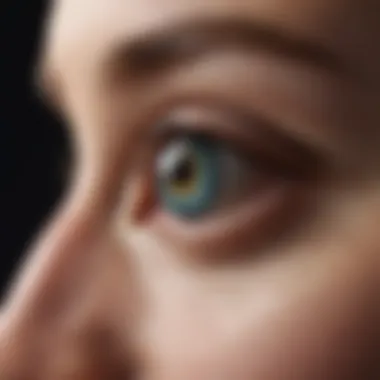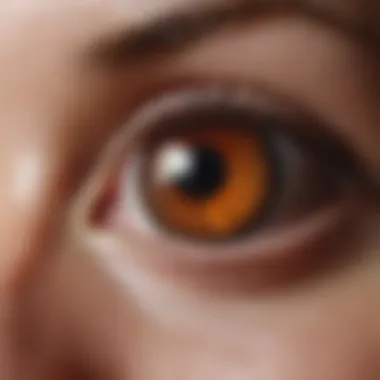Ocular Photodynamic Therapy: Innovations and Applications


Intro
Ocular photodynamic therapy (PDT) is reshaping the landscape of treatment methodologies for a range of eye disorders, particularly those linked to neovascularization and neoplasm development. This technique utilizes photosensitive compounds, which are activated by specific wavelengths of light to target abnormal cellular activities. In this article, we seek to underscore the multifaceted dimensions of PDT, exploring its operational mechanisms and clinical relevance through substantial research insights.
In recent years, the field has witnessed substantial advancements aimed at amplifying the efficacy of PDT, incorporating cutting-edge technologies and innovative methods. As we delve deeper, we will dissect how these transformations are not merely incremental; they signify a considerable shift towards personalized and less invasive treatment alternatives, which presents an attractive proposition for both patients and clinicians alike.
"The paradigm shift in ocular treatment illustrates a crucial move towards targeted strategies that promise enhanced outcomes with reduced complications."
Understanding the intricate interplay between PDT applications and technological developments enhances our grasp of its potential therapeutic benefits. Therefore, this article aims to provide a detailed exploration for students, researchers, educators, and professionals in the field.
Prologue to Ocular Photodynamic Therapy
Ocular photodynamic therapy (PDT) stands as a revolutionary technique in the realm of ophthalmology. Its capacity to treat specific eye conditions elevates it above traditional methods. This section delves into the profound significance of PDT, shedding light on its mechanics, historical evolution, and potential benefits within clinical practice.
Definition and Overview
Ocular photodynamic therapy involves a light-sensitive drug, known as a photosensitizer, that targets pathological tissues in the eye. Once activated by a specific wavelength of light, this therapy induces a photochemical reaction, leading to cellular damage distinct to the targeted area. This approach allows for precision in treatment, reducing collateral damage to surrounding healthy tissues. PDT's broad utility in treating conditions like age-related macular degeneration highlights its relevance in contemporary ocular medicine.
Historical Context
PDT's journey in ocular therapy began in the latter half of the 20th century. Initially developed for oncology, the principles of photodynamic therapy gradually found applications in ophthalmology. Key milestones occurred in the 1990s with the introduction of verteporfin as a photosensitizer for choroidal neovascularization. Various studies since then have validated its effectiveness, leading to advancements in technology and treatment protocols. The treatment's evolution reflects ongoing efforts to enhance efficacy while prioritizing patient safety. This historical trajectory underscores the importance of research and the promise PDT holds for future ocular treatments.
Mechanism of Action in Ocular Photodynamic Therapy
The Mechanism of Action in Ocular Photodynamic Therapy (PDT) is a critical area of focus, as it lays the groundwork for understanding how this treatment can effectively target various ocular conditions. The efficacy of PDT relies on the precise interaction between light, photosensitizer agents, and the cellular structures within the eye. This section discusses the core components of PDT mechanics, highlighting the importance of this knowledge for both clinicians and researchers.
Photosensitizer Agents
Photosensitizer agents are essential to the success of ocular PDT. These compounds are primarily activated by specific wavelengths of light. Once activated, they undergo a chemical reaction that creates reactive oxygen species (ROS), which can damage or destroy nearby cells. The selection of an appropriate photosensitizer is crucial, as different agents possess unique absorption properties and affinities for various types of cancer or ocular disease cells.
Some widely used photosensitizers include verteporfin and talaporfin sodium. Each agent works differently, forming a vital part of the treatment protocol based on the condition being targeted. This specificity enhances treatment effectiveness and minimizes damage to surrounding healthy tissues.
Activation Process
The activation process involves the administration of light after the photosensitizer has been introduced into the ocular tissue. The timing and intensity of this light exposure are key factors that influence the treatment's outcome. Typically, a laser or intense light-emitting device is used to provide the required light at a precise wavelength that corresponds to the absorption peak of the employed photosensitizer.
This step is momentous as it triggers a photochemical reaction, facilitating cellular destruction through the generation of ROS. The effectiveness of this process is contingent upon several factors:
- The concentration of the photosensitizer in the target tissue
- The duration of light exposure
- The distance from the light source to the target tissue.
In this manner, the activation process transforms the therapeutic potential of PDT from a theoretical approach into clinical reality.
Cellular Response to Photodynamic Therapy
When ocular cells are exposed to the reactive oxygen species produced by the activated photosensitizers, several cellular responses can occur. These include apoptosis (programmed cell death), necrosis, and disruption of angiogenic pathways. The subsequent processes are crucial as they determine treatment success and patient outcomes.
- Apoptosis offers a more controlled form of cell death, favoring the preservation of surrounding healthy cells. It is generally induced by the oxidative stress that results from ROS.
- Necrosis, in contrast, leads to inflammation and can have adverse effects on neighboring tissues.
- Disruption of Angiogenic Pathways is particularly relevant in conditions such as age-related macular degeneration, where abnormal blood vessel growth needs to be managed.
In summary, understanding the cellular responses to PDT is important in refining treatment techniques and customizing approaches based on individual patient needs.
The interplay of photosensitizers, activation light, and cellular responses establishes a sophisticated mechanism that underscores the potential of ocular PDT in contemporary medicine.


Clinical Applications of Ocular Photodynamic Therapy
The segment of ocular photodynamic therapy (PDT) related to clinical applications represents a crucial area of focus. It provides insight into how PDT is implemented in various ocular diseases, yielding significant advancements in treatment efficacy. This exploration not only showcases the versatility of PDT but also highlights its essential role in managing conditions that previously lacked effective solutions. By understanding the direct application of PDT, professionals can appreciate its impact on patient outcomes and quality of life.
Age-Related Macular Degeneration
Age-related macular degeneration (AMD) is a leading cause of vision loss among older adults. PDT has emerged as a compelling option for patients suffering from the neovascular form of AMD. This approach utilizes photosensitizers such as verteporfin, which targets abnormal blood vessels in the retina.
The mechanism is straightforward: upon laser activation, the photosensitizer produces reactive oxygen species (ROS) that selectively destroy the neovascular tissues without affecting surrounding healthy structures. Success rates of PDT in stabilizing vision and even improving visual acuity are notable. The benefits include:
- Targeted Treatment: Minimizes damage to surrounding healthy retinal areas.
- Reduced Recurrence: PDT often results in less frequent treatments compared to traditional methods.
- Preservation of Sight: Many patients experience better preservation of central vision.
PDT holds a prominent place in the treatment protocols for AMD, allowing more nuanced management strategies tailored to individual patient needs.
Choroidal Neovascularization
Choroidal neovascularization (CNV) is another significant area where ocular PDT has shown efficacy. Identified as a consequence of conditions like AMD and ocular inflammatory diseases, CNV involves the abnormal growth of blood vessels beneath the retina, leading to potential vision loss. PDT has been effectively utilized to treat CNV by targeting these abnormal vessels.
The procedure, much like with AMD, employs photosensitizers activated by specific wavelength lasers. The controlled destruction of these newly formed vessels helps mitigate the adverse effects of CNV. The advantages of using PDT for CNV are substantial:
- Precision: Directly addresses the affected areas with minimal collateral damage.
- Long-lasting Results: Some patients report prolonged intervals between necessary treatments.
- Improved Outcomes: Long-term studies indicate enhanced visual function in many treated cases.
Thus, PDT serves as a crucial tool in the fight against CNV, providing a specialized solution to a complex ocular issue.
Ocular Tumors
The application of PDT extends into the treatment of ocular tumors, including choroidal melanoma and conjunctival tumors. This method is advantageous due to its minimally invasive nature and precision in targeting tumor cells.
In these cases, PDT facilitates tumor reduction or complete eradication with fewer side effects than traditional surgical methods. The procedure entails:
- Administration of Photosensitizers: These compounds preferentially accumulate in tumor cells.
- Laser Activation: The application of light triggers the photosensitizer, leading to cell death primarily through necrosis and apoptosis.
- Post-Treatment Monitoring: Continual evaluation is critical to assess the treatment efficacy and monitor for any recurrence.
The benefits here also emphasize the importance of PDT in oncology:
- Accessibility: It can be performed in an outpatient setting.
- Cosmetic Outcomes: Less scarring and improved cosmetic results post-treatment compared to conventional approaches.
- Enhanced Survival Rates: For certain tumor types, studies suggest improved survival outcomes when combined with conventional therapies.
In summary, the clinical applications of ocular photodynamic therapy present a significant advancement in managing diverse ocular conditions, especially those related to neovascularization and malignancy. Through targeted treatment approaches, PDT enhances patient care by maximizing therapeutic benefits while minimizing potential complications.
Emerging Technologies in Photodynamic Therapy
Emerging technologies in photodynamic therapy (PDT) are transforming the landscape of ocular treatment. As this field evolves, innovations bring exciting potentials and work towards improving patient outcomes. The integration of advanced techniques in photodynamic therapy enhances efficacy, minimizes side effects, and promotes personalized treatment strategies. Understanding these technological advancements allows for improved treatment protocols and encourages ongoing research.
Advancements in Photosensitizers
The development of photosensitizers plays a critical role in enhancing PDT effectiveness. Traditionally, photosensitizers such as verteporfin have been used, but newer agents are surfacing, providing benefits like increased selectivity and reduced tissue toxicity. Recent advancements involve the bridging of chemical properties to enhance drug distribution within ocular tissues. New formulations offer improved absorption and dosimetry, which can lead to better outcomes in neovascular conditions. For instance, agents that can inherently target specific cells or tissues can provide a more tailored approach to treatment.
Effective photosensitizers can significantly increase treatment success by increasing the precision of targeting, reducing collateral damage to healthy tissues.
Innovations in Light Delivery Systems
Light delivery systems are crucial in determining the overall success of PDT. Recent innovations include fiber-optic systems, which allow for more localized and controlled light application. This approach can optimize the light dosage delivered to the target area while minimizing exposure to surrounding healthy tissue. Moreover, advancements in laser technology, including tunable lasers, enable healthcare providers to adjust wavelengths for more effective activation of different types of photosensitizers. These enhancements enhance treatment precision and expand the applications of PDT in various ocular diseases.


Nanotechnology in PDT
Nanotechnology is emerging as a promising frontier in ocular photodynamic therapy. By utilizing nanoparticles as carriers for photosensitizers, researchers can enhance the delivery and efficacy of these agents. Nanoparticles can potentially improve the solubility and stability of photosensitizers, leading to better therapeutic outcomes. Furthermore, smart nanoparticles offer the ability to release their payload in a controlled manner or respond to specific stimuli, like pH changes, at the targeted site, ensuring that photosensitizers are activated only in the desired area. This targeted approach enhances effectiveness, reduces side effects, and paves the way for more innovative therapeutic strategies.
In summary, the advancements in photosensitizers, light delivery systems, and nanotechnology are fostering significant changes in ocular photodynamic therapy. As research progresses, new technologies will likely improve outcomes for patients suffering from various ocular conditions.
Clinical Efficacy and Outcomes
Clinical efficacy and outcomes of ocular photodynamic therapy (PDT) are critical aspects to examine, especially in relation to current treatment strategies for various ocular disorders. Understanding these elements enables healthcare professionals to make informed decisions regarding treatment plans and patient management. By assessing the efficacy of PDT, we can derive valuable insights on success rates, patient satisfaction, and overall impact on visual health.
Success Rates in Treatment
Success rates in PDT treatment have been of significant focus in recent research. Various studies indicate that PDT provides favorable outcomes for conditions like age-related macular degeneration (AMD) and choroidal neovascularization (CNV). In AMD, studies report success rates ranging from 60% to 70% in halting vision loss, highlighting the therapy's potential in preserving visual function.
Some factors influence these success rates:
- Photosensitizer used: Different agents may yield varied outcomes.
- Stage of disease: Early detection often correlates with enhanced efficacy.
- Patient adherence: Following post-treatment care protocols can improve results.
"Ocular photodynamic therapy has redefined treatment protocols for several ocular conditions, achieving notable success in patient outcomes."
Quality of Life Post-Treatment
The quality of life (QoL) following photodynamic therapy is another essential consideration when evaluating its clinical efficacy. Many patients report improvements in vision-related QoL following treatment. This improvement is not always solely based on the visual acuity but rather includes generalized satisfaction regarding their visual functioning in everyday situations.
Moreover, various studies have employed standardized questionnaires to measure changes in QoL post-PDT. Parameters assessed often include:
- Visual functioning: Patients may experience enhancements in their ability to perform daily activities.
- Psychological well-being: Reduction in anxiety and frustration caused by visual impairment.
- Social engagement: Patients often feel more connected to social activities post-treatment.
Overall, both the success rates in treatment and the quality of life improvements post-therapy are paramount in advocating for wider application of ocular PDT. Further research in these areas will not only enhance our understanding but also guide optimization strategies for maximizing patient benefits.
Safety and Adverse Effects
Understanding the safety and potential adverse effects of ocular photodynamic therapy is critical for both practitioners and patients. This therapy, while innovative, is not without risks. Clear knowledge of its implications informs not just the clinical application but also builds trust with those undergoing treatment. The benefits of PDT can only be fully realized when its safety profile is well understood. Therefore, examining the common side effects and long-term considerations allows for better patient management and improved outcomes.
Common Side Effects
Patients may experience a range of common side effects after undergoing ocular photodynamic therapy. These are conditions that can arise as the body responds to the treatment process. They typically include:
- Photosensitivity: Many patients report increased sensitivity to light, which might last for several days.
- Visual Disturbances: Temporary changes in vision, including blurred vision or fluctuations in visual acuity, are not uncommon. These symptoms often resolve on their own.
- Ocular Discomfort: Mild pain or discomfort can occur in the treated eye. It is important for patients to communicate any discomfort to their healthcare team promptly.
- Injection Site Reactions: If an intravenous photosensitizer is used, localized reactions may occur at the injection site, such as redness or swelling.
While these side effects can be troubling, they are usually transient. Most patients find that symptoms diminish significantly after the initial recovery period. A careful pre-treatment assessment can help identify individuals who may be at higher risk of experiencing these side effects.
Long-Term Safety Considerations
When evaluating ocular photodynamic therapy, it is essential to think about its long-term safety. This involves several considerations:
- Chronic Health Monitoring: Regular follow-up appointments are necessary to monitor any long-term effects of the therapy. This includes checking for potential retinal toxicity, which could emerge as a concern with repeated treatments.
- Patient-Specific Responses: Each patient reacts differently to PDT. Factors such as age, underlying health conditions, or concurrent medication can influence long-term outcomes. Consequently, individualized treatment plans are essential.
- Research and Data Collection: Ongoing research continues to assess the long-term implications of PDT. Gathering data from treated patients will enhance our understanding of its efficacy and safety, ensuring that practices can evolve alongside new findings.
- Risk-Benefit Analysis: A thorough discussion of the risks versus the anticipated benefits remains fundamental. This consideration helps practitioners and patients make informed decisions that align with their treatment goals.
The efficacy of photodynamic therapy hinges on an accurate assessment of both its immediate and long-term safety profile.
Regulatory and Ethical Considerations


In the realm of ocular photodynamic therapy (PDT), regulatory and ethical considerations play a crucial role in ensuring that treatments are both safe and effective for patients. These considerations guide the approval processes for PDT agents and highlight the ethical implications that arise from clinical application. Understanding these facets is not merely an academic exercise; it is essential for any practitioner involved in the use of PDT, ensuring compliance with medical standards and advocacy for patient welfare.
Approval Processes for PDT Agents
The approval process for PDT agents is rigorous and multifaceted. Before a photosensitizer can be utilized clinically, it must undergo extensive preclinical studies to evaluate its safety and effectiveness. These studies typically involve in vitro assessments and animal trials. Following successful preclinical results, the process advances to human clinical trials, which are conducted in phases:
- Phase 1: Focused on assessing safety, this phase involves a small group of subjects to determine dosage and find side effects.
- Phase 2: A larger group is tested to further assess safety and begin evaluating effectiveness.
- Phase 3: This phase involves randomized and controlled trials with diverse populations, aiming to provide comprehensive data on efficacy and monitor adverse effects.
After completion of these phases, the gathered data is submitted to regulatory agencies like the U.S. Food and Drug Administration (FDA) or the European Medicines Agency (EMA) for review. Regulatory bodies evaluate all submitted data before granting market approval, ensuring that products meet strict safety standards. This safeguards patients while ensuring that effective treatments become available.
Ethical Implications in Treatment
Ethical considerations in ocular photodynamic therapy are equally important. They encompass a variety of factors that influence both patient safety and informed consent. Firstly, the notion of informed consent requires healthcare providers to thoroughly discuss potential risks, benefits, and alternatives with patients prior to treatment. This involves not just providing information but also ensuring patients comprehend their choices and implications fully.
Additionally, ethical guidelines dictate that clinical trials must be conducted with integrity and transparency. This includes reporting adverse effects accurately and not manipulating data to favor positive outcomes. Ultimately, ethical practice in PDT extends to how practitioners choose to offer treatments and manage patient expectations.
"The commitment to ethical standards in ocular photodynamic therapy is not merely a regulatory obligation but a fundamental principle that underscores the integrity of medical practice."
In summary, the intersection of regulatory frameworks and ethical guidelines curates a pathway for the responsible use of PDT. As the landscape of ocular therapies continues to evolve, staying abreast of regulatory and ethical developments will be imperative for all stakeholders involved. This ensures that innovations in photodynamic therapy are not only effective but also align with the broader principles of biomedical ethics.
Future Directions in Ocular Photodynamic Therapy
The trajectory of ocular photodynamic therapy (PDT) is poised for significant transformations, as it increasingly becomes a cornerstone in ocular treatment modalities. This progress hinges on understanding specific innovations, enhancing efficacy, and the integration of various therapeutic approaches. The importance of discussing future directions in PDT cannot be understated. A multi-faceted examination of these directions yields insights into how ongoing research and development will redefine patient care in ophthalmology.
Research Trends and Focus Areas
The current research landscape for ocular photodynamic therapy reflects a dynamic shift towards innovative solutions customized for diverse ocular conditions. Key focus areas include the refinement of photosensitizer agents, aimed at improving their specificity and reducing potential side effects. Researchers are actively pursuing agents that are activated at lower light doses, which may enhance safety and overall patient experience.
Additionally, studies are exploring targeting mechanisms that allow PDT to selectively illuminate pathological tissue, sparing healthy structures. This precision in targeting can minimize collateral damage, enhancing the overall effectiveness of the therapy. Moreover, there is a growing interest in the role of artificial intelligence in optimizing treatment protocols and predicting patient outcomes. This expectation suggests a future where therapy is not just more effective, but also personalized based on individual patient profiles.
Furthermore, interdisciplinary collaborations are encouraging innovation in light delivery systems, enabling more effective and localized treatment. With advancements in materials science, researchers are innovating with nanoparticles and smart drug delivery systems that promise to revolutionize the way PDT is administered.
Potential for Combination Therapies
In recent years, a significant trend has emerged emphasizing the combination of ocular photodynamic therapy with other treatment modalities. The integration of PDT alongside conventional therapies such as anti-VEGF (vascular endothelial growth factor) agents presents a promising avenue for improving patient outcomes. This approach may provide synergistic effects, enhancing overall efficacy while potentially lowering the dosage required of either therapy, thus mitigating side effects.
Additionally, combining PDT with immunotherapy is an area gaining traction in recent studies. By harnessing the immune system while targeting specific tumors or neovascularization, there is potential for more comprehensive treatment options.
Such combination therapies enhance the therapeutic landscape by broadening the arsenal available to clinicians, potentially leading to better management of complex diseases like age-related macular degeneration and ocular tumors.
As researchers continue to explore and validate these combinations, the results could facilitate new standard-of-care protocols that are rooted in evidence-based practices. Such developments could greatly influence future treatment algorithms, reinforcing the notion that ocular photodynamic therapy is not a static solution but rather a versatile and evolving therapeutic option.
"The transformation of PDT through innovative research and integration of combination therapies is pivotal in shaping the future landscape of ocular medicine."
Overall, the future directions of ocular photodynamic therapy indicate a vibrant field where innovation, precision medicine, and comprehensive approaches converge to reinforce therapeutic outcomes for patients with ocular conditions.
Epilogue
The conclusion serves as a critical component of the discourse surrounding ocular photodynamic therapy (PDT). It crystallizes the essential insights gleaned from the prior sections and underscores the relevance of PDT in contemporary ocular medicine.
Summary of Key Findings
Throughout this article, we have traversed the intricate landscape of ocular PDT. Key findings include the impressive efficacy of PDT in treating conditions like age-related macular degeneration and choroidal neovascularization. Studies suggest that PDT offers advantages over traditional therapies, such as reduced invasiveness and the potential for targeted treatment of ocular tumors. The advancements in photosensitizers and light delivery systems further bolster the effectiveness of PDT. This therapy not only approaches treatment holistically but also enhances the quality of life for patients through better management of ocular disorders.
Final Thoughts on PDT's Role in Ocular Medicine
In closing, photodynamic therapy holds significant promise in advancing ocular medicine. The growing body of research continues to drive innovations that refine therapy applications and improve patient outcomes. As we look to the future, the potential for combining PDT with other therapeutic modalities could lead to even more effective treatment regimens. Emphasizing continuous research and ethical considerations remains vital in ensuring that the benefits of PDT are realized fully across diverse patient populations. Understanding both the mechanism and clinical context of PDT paves the way for its integration into routine patient care, making it a focal point of future ocular health strategies.



